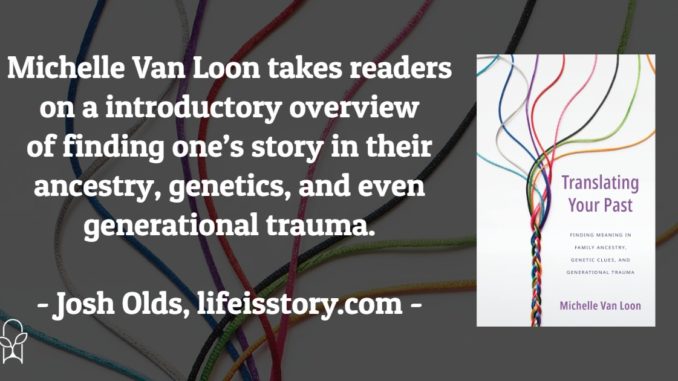
Published by Herald Press on February 22, 2022
Genres: Non-Fiction, Christian Life
Buy on Amazon
Goodreads

Uncover the spiritual strength of your family story.
We all have a desire to learn more about where we’ve come from, and technology has made this more possible than ever. But our family stories are more than a list of DNA results on a piece of paper or a bunch of fading Kodachrome images filling old photo albums.
In an era often marked by both fragmentation in family and culture and a hunger to discover our genetic roots, our family stories—including the difficult, complex ones—can carry great spiritual strength. The desire to trace, interpret, and pass on our family’s history is embedded in Scripture from beginning to end—there are nine genealogies found in the book of Genesis alone. When we bring together the various threads of our family stories with Scripture’s insights, they can provide the key to decoding our identity and helping us discover our place in family, church, and world. In Translating Your Past, author Michelle Van Loon helps readers uncover how patterns and gaps in family histories, generational trauma, adoption, genetic clues and surprises, spiritual history, and the church help us translate our own pasts and understand why these stories matter. Each chapter includes questions designed for individual reflection or small group discussion, as well as an appendix of helpful tools readers can use to translate their own pasts and create meaning in order to transform their unique family history into living, faith-filled heritage.
Our past matters. We are a product of where we come from. If life is story, then the stories of our ancestors are the prologue that sets the context for our own lives. Some of this goes back centuries in determining our ethnic and cultural identities. Some of it comes within the past hundred years as how our grandparents and parents were raised—and where they were raised—effects our own lives. In Translating Your Past, Michelle Van Loon takes readers on a introductory overview of finding one’s story in their ancestry, genetics, and even generational trauma.
Every chapter in Translating Your Past could be its own book, which is both the strength and the weakness of Van Loon’s writing. It is intended to be introductory and comprehensive—covering everything from the genetic and biological components of ancestry to the corollary sociological and religious factors. As such, there’s something for everyone, but Van Loon is not able to do a deep dive on any one area.
This is probably best, as Van Loon is admittedly not an academic expert in any of these areas, but comes to the topic as an interested and personally invested layperson whose personal family history is fraught with pain and trauma. Translating Your Past opens with Van Loon asking her mother a question that broke “an unwritten rule in my family”—“Don’t you ever wonder where you come from?” In considering her own story, Van Loon invites readers to consider their own.
I was most interested in this book for its chapter on adoption. I have two adopted children who are from a different ethnic background than either me or my wife. We have some information on their biological mothers, virtually nothing on their fathers. All family history sections on medical history forms simply say “adopted” because that’s all we know. In the past, adoptions were often informal and interfamilial—and occasionally secret. (That’s part of Van Loon’s family history.) Today, there is greater knowledge of how understanding one’s biological and ethnic background is a necessary component of adoption. In this chapter, Translating Your Past speaks both sensibly and sensitively about adoption, encouraging readers to gently face the difficult issues.
Overall, Translating Your Past is a good starting point. Van Loon provides discussion questions at the end of each chapter to allow readers to reflect and think over the text. I wish that there had been suggestions for further study. While you can glean some valuable resources from the footnotes, I think the book would have been improved by offering readers a map to the next step on their journey. If you’re already in the place of untangling generational trauma or learning about your past, some of what this book has to say may be too general for you. However, if you’re feeling the need to start and don’t know where to begin, Michelle Van Loon will point you in the correct direction.
